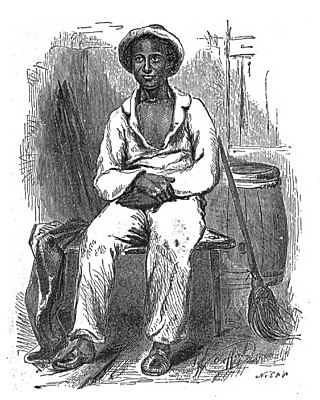
Solomon Northup was an American abolitionist and the primary author of the memoir Twelve Years a Slave. A free-born African American from New York, he was the son of a freed slave and a free woman of color. A farmer and a professional violinist, Northup had been a landowner in Washington County, New York. In 1841, he was offered a traveling musician's job and went to Washington, D.C. ; there he was drugged and kidnapped into slavery. He was shipped to New Orleans, purchased by a planter, and held as a slave for 12 years in the Red River region of Louisiana, mostly in Avoyelles Parish. He remained a slave until he met Samuel Bass, a Canadian working on his plantation who helped get word to New York, where state law provided aid to free New York citizens who had been kidnapped and sold into slavery. His family and friends enlisted the aid of the Governor of New York, Washington Hunt, and Northup regained his freedom on January 3, 1853.

Washington, D.C., formally the District of Columbia and commonly called Washington or D.C., is the capital city and the federal district of the United States. The city is located on the east bank of the Potomac River, which forms its southwestern border with Virginia and borders Maryland to its north and east. Washington, D.C. was named for George Washington, a Founding Father, victorious commanding general of the Continental Army in the American Revolutionary War and the first president of the United States, who is widely considered the "Father of his country". The district is named for Columbia, the female personification of the nation.

The Pearl incident was the largest recorded nonviolent escape attempt by enslaved people in United States history. On April 15, 1848, seventy-seven slaves attempted to escape Washington D.C. by sailing away on a schooner called The Pearl. Their plan was to sail south on the Potomac River, then north up the Chesapeake Bay and Delaware River to the free state of New Jersey, a distance of nearly 225 miles (362 km). The attempt was organized by both abolitionist whites and free blacks, who expanded the plan to include many more enslaved people. Paul Jennings, a former slave who had served President James Madison, helped plan the escape.

The internal slave trade in the United States, also known as the domestic slave trade, the Second Middle Passage and the interregional slave trade, was the mercantile trade of enslaved people within the United States. It was most significant after 1808, when the importation of slaves from Africa was prohibited by federal law. Historians estimate that upwards of one million slaves were forcibly relocated from the Upper South, places like Maryland, Virginia, Kentucky, North Carolina, Tennessee, and Missouri, to the territories and then-new states of the Deep South, especially Georgia, Alabama, Louisiana, Mississippi, and Arkansas.

The Franklin and Armfield Office, which houses the Freedom House Museum, is a historic commercial building in Alexandria, Virginia. Built c. 1810–1820, it was first used as a private residence before being converted to the offices of the largest slave trading firm in the United States, started in 1828 by Isaac Franklin and John Armfield. Another source, using ship manifests in the National Archives, gives the number as "at least 5,000".
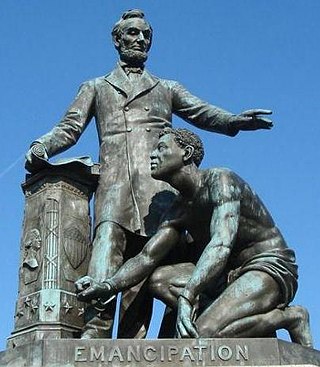
The Emancipation Memorial, also known as the Freedman's Memorial or the Emancipation Group is a monument in Lincoln Park in the Capitol Hill neighborhood of Washington, D.C. It was sometimes referred to as the "Lincoln Memorial" before the more prominent so-named memorial was dedicated in 1922.

Lumpkin's Jail, also known as "the Devil's half acre", was a holding facility, or slave jail, located in Richmond, Virginia, just three blocks from the state capitol building. More than five dozen firms traded in enslaved human beings within blocks of Richmond's Wall Street between 14th and 18th Streets between the 1830s and the end of the American Civil War. Its final and most notorious owner, Robert Lumpkin, bought and sold slaves throughout the South for well over twenty years, and Lumpkin's Jail became Richmond's largest slave-holding facility.
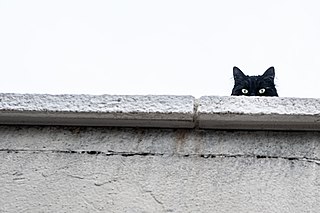
The Demon Cat is a ghost cat who is purported to haunt the government buildings of Washington, D.C., which is the capital city of the United States. Its primary haunts are the city's two main landmarks: the White House and the United States Capitol.
Thomas Jefferson, the third president of the United States, owned more than 600 slaves during his adult life. Jefferson freed two slaves while he lived, and five others were freed after his death, including two of his children from his relationship with his slave Sally Hemings. His other two children with Hemings were allowed to escape without pursuit. After his death, the rest of the slaves were sold to pay off his estate's debts.

Being the site of military battles, deadly duels, assassinations, untimely deaths, and other associated tragedies, there are a number of reportedly haunted locations in Washington, D.C., the capital city of the United States.
The following is a timeline of the history of Washington, D.C., the capital city of the United States.

Michael G. Shiner (1805–1880) was an African-American Navy Yard worker and diarist who chronicled events in Washington D.C. for more than 60 years, first as a slave and later as a free man. His diary is the earliest-known by an African American resident of the District of Columbia. The diary has numerous entries which have provided historians a firsthand account of the War of 1812, the British Invasion of Washington, the burning of the U.S. Capitol and Navy Yard, and the rescue of his family from slavery as well as shipyard working conditions,1835 Washington Navy Yard labor strike, Snow Riot, racial tensions and other issues and events of nineteenth century, military and civilian life.
Austin Woolfolk (1796–1847) was an American slave trader. Among the busiest slave traders in Maryland, he trafficked more than 2,000 enslaved people through the port of Baltimore to the port of New Orleans, and became notorious in time for selling Frederick Douglass's aunt, and for assaulting Benjamin Lundy after the latter had criticized him.
Jeff Forret is an American historian and professor at Lamar University.

In the District of Columbia, the slave trade was legal from its creation until it was outlawed as part of the Compromise of 1850. That restrictions on slavery in the District were probably coming was a major factor in the retrocession of the Virginia part of the District back to Virginia in 1847. Thus the large slave-trading businesses in Alexandria, such as Franklin & Armfield, could continue their operations in Virginia, where slavery was more secure.
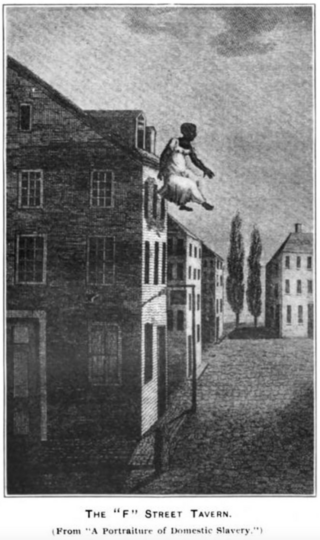
Anna "Ann" Williams was an enslaved woman who successfully sued for freedom for herself and her children before the United States Court of Appeals for the DC Circuit. Her lawsuit and her infamous jump from the window of the F Street Tavern heightened public awareness of the terror and suffering caused by the slave trade in the United States.
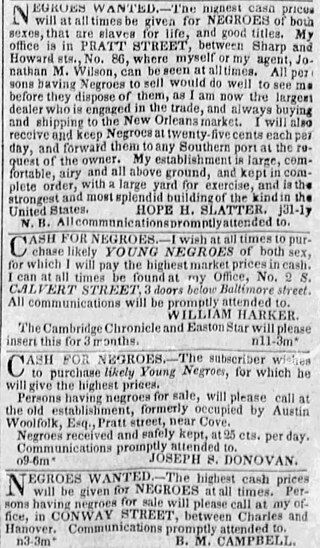
Bernard Moore Campbell, often listed professionally as B. M. Campbell, operated an extensive slave-trading business in the antebellum U.S. South. Campbell, in company with Austin Woolfolk, Joseph S. Donovan, and Hope H. Slatter, has been described as one of the "tycoons of the slave trade" in the Upper South, "responsible for the forced departures of approximately 9000 captives from Baltimore to New Orleans."

Slave markets and slave jails in the United States were places used for the slave trade in the United States from the founding in 1776 until the total abolition of slavery in 1865. Slave pens, also known as slave jails, were used to temporarily hold enslaved people until they were sold, or to hold fugitive slaves, and sometimes even to "board" slaves while traveling. Slave markets were any place where sellers and buyers gathered to make deals. Some of these buildings had dedicated slave jails, others were negro marts to showcase the slaves offered for sale, and still others were general auction or market houses where a wide variety of business was conducted, of which "negro trading" was just one part.

George Kephart was a 19th-century American slave trader, land owner, farmer, and philanthropist. A native of Maryland, he was an agent of the interstate trading firm Franklin & Armfield early in his career, and later occupied, owned, and finally leased out that company's infamous slave jail in Alexandria. In 1862, Henry Wilson of Massachusetts mentioned Kephart by name in a speech on the floor of the U.S. Senate as one of the traders who had "polluted the capital of the nation with this brutalizing traffic" of selling people.

Joseph S. Donovan was an American slave trader known for his slave jails in Baltimore, Maryland. Donovan was a major participant in the interregional slave trade, building shipments of enslaved people from the Upper South and delivering them to the Deep South where they would be used, for the most part, on cotton and sugar plantations. As one Baltimore historical researcher and tour guide summarized, "the change from raising tobacco to wheat in the region caused a surplus of labor, whereas the South needed more labor due to the invention of the cotton gin". Donovan, in company with Austin Woolfolk, Bernard M. Campbell, and Hope H. Slatter, have been described as one of the "tycoons of the slave trade" in the Upper South, "responsible for the forced departures of approximately 9000 captives from Baltimore to New Orleans."
















